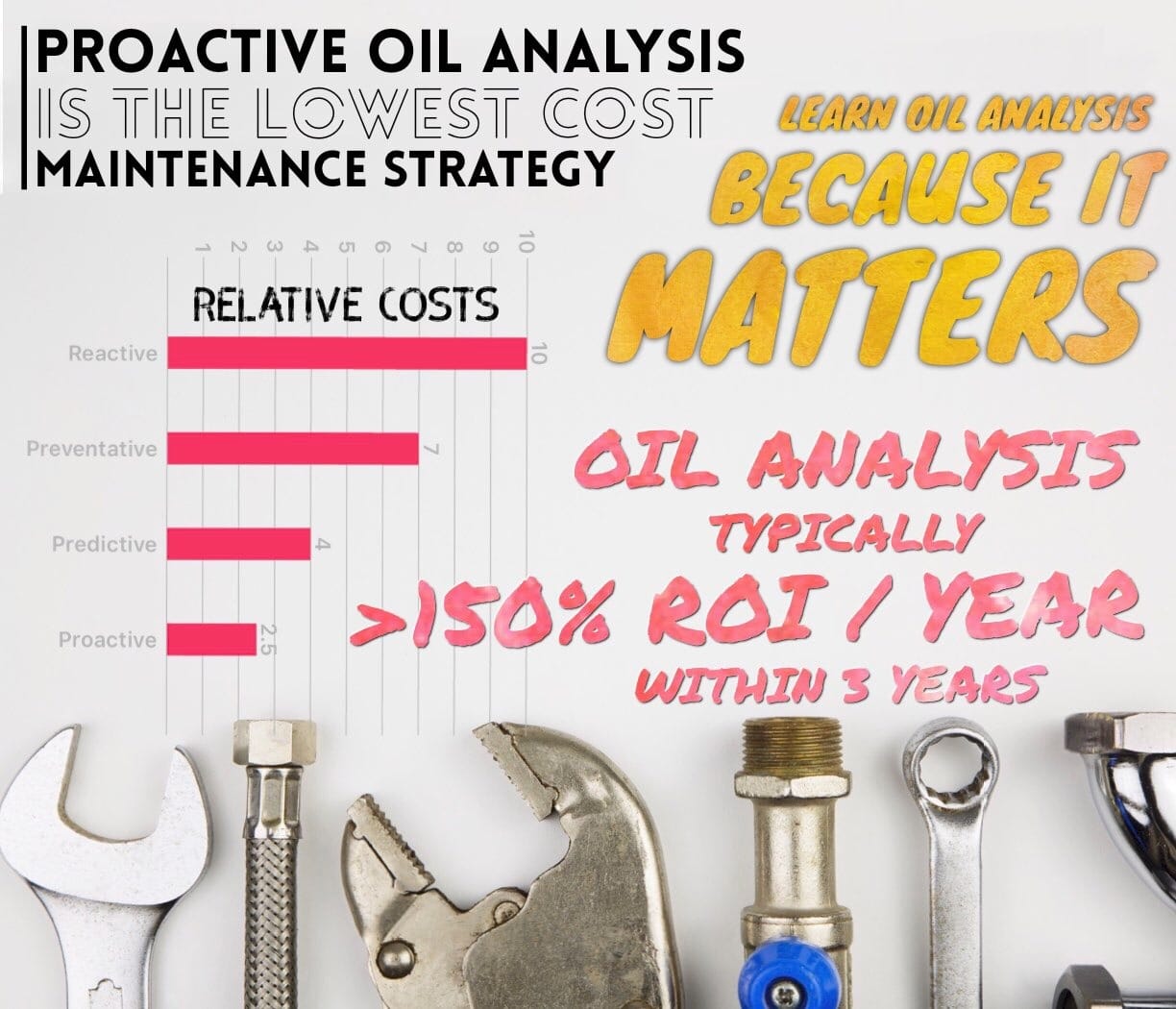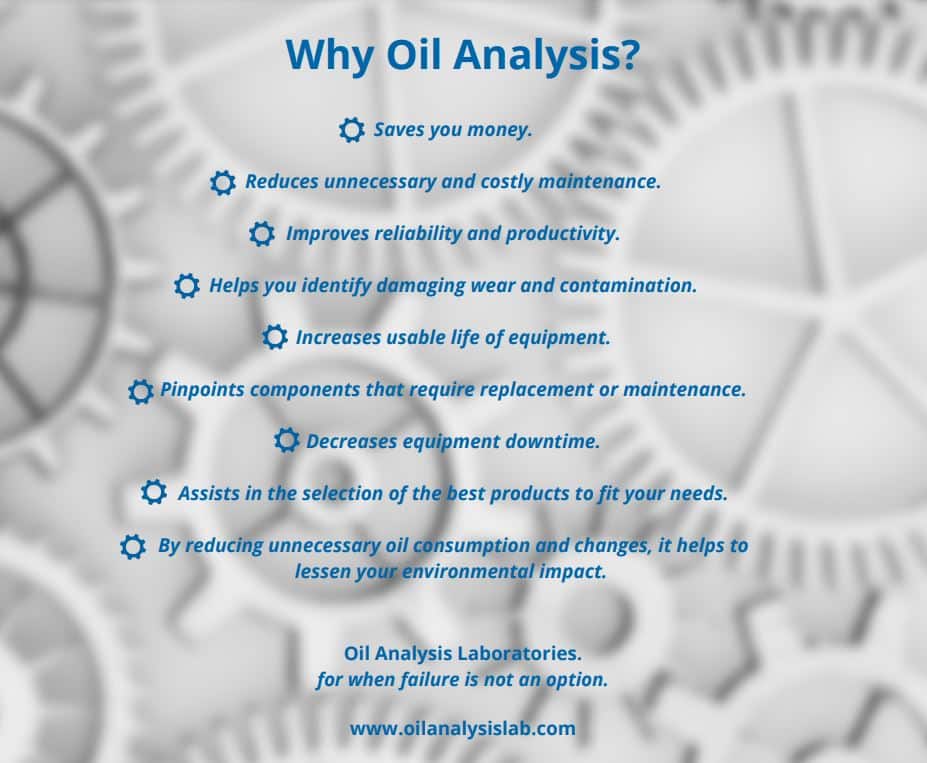This article answers the following questions:
- How to reduce machinery downtime?
-
How to reduce machine repair costs?
-
How to reduce lubricant oil and grease consumption?
-
How to improve machinery reliability?
- How big is the impact of wear on a business?
- With such a list of questions above to answer you would imagine this article would be very detailed but in fact it can be summed up in two words “Oil” and “Analysis”. I personally live and breathe oil analysis as I was born into it with my father one of the world authorities on the subject having built Europes largest independent lab over 35 years. So you would be forgiven in thinking I have a vested interest to promote the concept of oil analysis. However, oil analysis had long since proven itself even before I came into this world and in fact dates back to World War II. As you probably know during these times resources were scarce and the impact of machinery failure was literally the difference between life and death. Hence early work began on monitoring US military locomtives and eventually extended into the other forces such as the Navy. Because of this coordinated effort between all the forces it became known as the Joint Oil Analysis Programme (JOAP) of which many measurements such as oxidation of an oil are still measured using these principles.
- The programme proved to be a huge success with reliability, fuel consumption and efficiency of machinery at an all time high as a result.

- It was later adopted all over the world and every type of machine that is lubricated is now tested by some form of oil analysis.
- So how does it work? Well the principle benefits are still the same as they were when it was first invented and one of the main benefits is it saves you money. This is not based on one or two case studies cobbled together by a laboratory trying to sell oil analysis, but something that has been proven time and time again in every industry segment, all over the world, for over 60 years.
- Don’t believe me? Then do a Google search for a study or contact any reputable oil analysis lab and they will be able to show you how the investment in oil analysis is far outweighed by the cost savings you will gain. All the big case studies show a cost saving and the only disagreement seems to be on how quick the return on investment is. In my experience it’s ~150% ROI within 3 years for most businesses, but this can be easily less than 12 months if your machinery is directly involved in production. The thing to remember the saving can also be on your very first sample and I have seen customers start an analysis trial unconvinced of whether to continue it after an initial trial only to have a major failure avoided though the programme.
- Machinery and component wear is still an absolutely huge economic issue with £10 billion lost each day world wide or £3.65 trillion a year. That is bigger than the GDP of the UK for 2017. The strange thing is that you never hear politicians raising this topic. So perhaps it wouldn’t be too big a stretch of the imagination to say oil analysis could have solved the financial crises of the past (although the wear in that figure also includes non lubricated machinery too). As someone living in Britian during the EU referendum we never saw save £10B on the side of a bus for Vote Sample, which would have been a far truer and more productive statement than what was printed. This cost can come from the wear to component, loss of power and inefficiency generated by the wear, the lube oil consumed by overheating wearing components as well as downtime and lost productivity.

- Unless you are the business owner or testing your own vehicle you will likely have to build some type of justification for starting an analysis programme for the people who sign the cheques. In which case it can be hard to justify the cost savings for something that could or could not happen in the future. Equally if you do run an analysis programme already it can equally be difficult in arguing for continuing the programme based on failures and shutdowns that haven’t happened. I have had a customer say to me they were considering stopping oil analysis as they hadn’t had a failure during the last 10 years they were with us – in which case the good job the lab is doing can sometimes start undoing the argument for continuing to use the service. I later managed to convince them to stay by showing some examples of how we had avoided failures from their analysis data.
- So in building your argument for the decision makers you need to answer two questions – how does oil analysis save you money and also how much? I will attempt to give you some outlines as to how you go about thinking about cost savings in your business?
-
How does Oil Analysis Save you money?
- There are several ways it saves you money:
Reduced unplanned downtime costs
- – this is by far the easiest selling point. If you have machinery that is in some way involved in your production process and it stopping means production stops then you need oil analysis. The returns on investment can easily exceed 10 to 1. Oil analysis helps identify problems before a failure so you don’t have to have a sudden shutdown to repair and can plan to repair them at a convenient time.
Reduced parts and labour costs
- – it is generally accepted that repairing before a failure is far less costly than a repair after a failure. In fact up to 60% less in many cases. Hence why a proactive maintenance strategy rather than a reactive one can give significant savings on your maintenance bills.
Reduces lubricant costs
- – did you know that without oil analysis, 85% of oil changes are actually done at the wrong time. Changing oil on a schedule is just a best guess, so you may be changing too early or too late. Neither of these scenarios being good for your machine or your wallet. By doing condition based oil changes you only need to change the oil when it’s actually needed saving you money on new lubricant, reduced costs of waste collection and a reduced carbon footprint.
-
How much will oil analysis save me and how do I calculate the cost savings?
- Oil analysis doesn’t mean a machine will never fail, as all machines will eventually fail regardless. What oil analysis does is help reduce the likelihood of premature failures and help you get the maximum life possible out of parts, lubricant and the machine. A failure is not just the cost of parts or labour but can also impact so many other areas so try not to limit yourself when building your case.
- I often like to give the example of a backup generator if it suddenly failed some of the impacts both financial and other negative impacts:
- The lights go off – is there a safety risk?
- Production stops – staff unable to work and so not productive.
- Overtime needed to catch up
- Customer’s orders missed or late delivery – impact of reputation in being able to deliver. Potential customer complaints or refunds?
- Quality of products or services impacted.
- Intermediate products if not stable or are perishable in production may be lost.
- Cost of parts
- Cost of urgent delivery on parts
- Labour cost to repair
- Higher insurance premiums if large repair bill.
- Increased loans if large repair bill.
- Low profits as low sales as lack of product to sell.
- Increased subcontracting costs if can’t catch up.
- What is the machine powering – are lives or other machines at risk when a machine fails?
To give you a hand in estimating the cost savings there are quite a few cost saving calculators you can use. I have a simple one in my Learn Oil Analysis book series you can print and work through. You need to register for our newsletter for free first to view it and all the other great content in the books, but all the content is free to look at here.
- Since I wrote the book I have fine tuned the formulas behind the calculations to include other potential cost savings as well as relate them to your business type, industry and turnover. So if you want to do a more detailed calculation and know your typical overhead costs etc then you can use the cost saving calculator at the bottom of my lab analysis FAQ page here.


